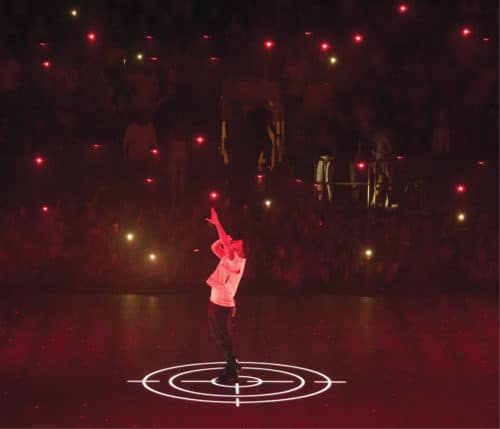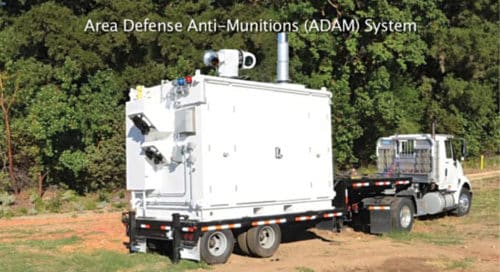Researchers are developing cyber solutions to defeat enemy drone swarm attacks. These solutions contain a multi-spectral sensor system that detects and characterises drone swarms. Using cyber electromagnetic activity, swarms are disabled so that life threat to native war fighters and citizens is avoided.
A drone swarm is a mass of tiny drones flying like a flock of birds that can perform coordinated tasks, controlled by an expert operator. A single operator from a portable ground unit can control up to fifty drones that can fly up to a hundred kilometres and carry payloads of one kilogram each, spending about an hour on the target.
Flocking drones are slowly becoming a major technological issue. Flocking behaviour is off course, and is common in the natural world, particularly among birds, fish and insects. It is now being observed in the technological world as well via drone swarms. We have seen that a large number of organisms can move collectively, maintaining direction and not hitting obstacles or each other.
In February 2018, 1218 drones formed Olympic rings in the sky at the opening ceremony of Winter Olympics in South Korea.
China has already tested a swarm of a thousand drones. Size of a swarm mainly depends on its mission or application.
Applications of a drone swarm are many, some of which include:
- Stage entertainment
- Hobbyist war games
- Animal herding on farms
- Search and rescue
- Spot-spraying during fire outbreaks, as in wildfires and the like
- Hunting thieves and spraying them with non-erasable ink
- Wi-Fi coverage
- Delivery of goods
- National and homeland security
Drone swarms have bigger applications in space exploration and can make space exploration faster, better and cheaper.
Conventional concerts can be sometimes boring, as these involve artists singing songs, with a bunch of spotlights beaming columns of colour through fake smoke. Swarms of artificially-intelligent drones are now being used for stage performances. In 2017, Verity Studio’s Lucie drone swarms completed more than 20,000 autonomous flights. These micro-drones gave stage performances at New York’s Madison Square Garden.

How a drone swarm system works
A drone swarm system has different algorithms. Theoretical frameworks are needed to design distributed flocking algorithms. Several factors need to be considered while designing a drone swarm. Four areas that must be looked at to unlock the full potential of a drone swarm are:
- Swarm size
- Customisation
- Diversity
- Hardening
The larger the size of the swarm, the greater the distance it can cover. For example, large under-water swarms can cover greater distances in search of adversary submarines or surface vessels.
Future drone swarms may not contain the same type and size of drones—these may consist of small- to large-sized drones with different payloads. These may also have drones that are equipped with different sensors to handle different functions. As a result, under-sea drones will be able to communicate with surface and aerial drones.
Robotic researchers have gone one step ahead and introduced drones that can self-organise and exhibit flocking behaviour (like birds). Hungarian Academy of Science has designed a drone swarm that can be operated in the real world without the use of a central control room. They have demonstrated this new model many times using computer simulations.
Constrained motions, communication capabilities, delays, feelings of getting upset or nervous, and so on are some of the factors that are still difficult to achieve while designing drone swarms. Scientists are working to overcome such problems as delays, uncertainties and kinematic constraints.
Each drone in the flock is separately programmed to follow specific flightpath. One of the main things required here is that all drones in the flock fly in the same direction and follow the same average position.
During flight, drones should not crash with obstacles like trees or collide with each other. However, autonomous collisions and object avoidance are yet unsolved problems. Present models exhibit heavy noise and come with inaccurate sensors and short-range communication devices. These problems need sophisticated analysis.
Swarming drones communicate with each other while in flight and can respond to changing conditions autonomously. A good example of this is a dense flock of singing birds reacting to a sudden threat like a bird of prey. The entire flock then exhibits a series of tasks and pretend to be a single organism.
Underlying challenges in the defence for drone swarms
In future, drone swarms can play a critical role in defence systems and warfare. The drone swarm attack on Russian forces in Syria is a good example of how this technology can be deployed. During the attack, six drones were intercepted by electronic warfare units; three exploded on touching the ground while the other three made landing outside the base. The remaining seven were destroyed using anti-aircraft missiles. This attack reveals that the age of drone swarms has arrived on the warfront.
Military drone swarms may incorporate drones equipped with anti-radiation and anti-jamming weapons. These can block hypersonic missiles. Swarms can be equipped with chemical, biological, radiological and nuclear detectors to provide homeland security.
Applying artificial intelligence (AI) to a drone swarm enables drones to imitate certain animals that work together. This is particularly helpful for synchronised tasks. The swarm’s intelligence relies heavily on AI. Real-time communication is important among drones in a swarm as drones need to communicate with each other using an airborne mesh network and with the control centre. A drone swarm can be operated from kilometres away.
“Terrorists and militants can operate small, inexpensive drones loaded with weapons to threaten the enemy and allied forces on the ground,” says Daniel Miller, chief engineer for high energy laser integration at Lockheed Martin Skunk Works. “Because of their size, these drones are difficult to see, hard to catch on the radar and hard to shoot with conventional weapons.”
A Q-53 radar has been developed that can detect and track such drone swarms and provide data to the command and control centre. The US is also developing a 60kW system equipped with multiple fibre lasers to generate high-power weapon beams to destroy enemy drone swarms. This laser weapon system can fire again and again, essentially creating unlimited groups of ‘bullets.’
Through internal research and development, Lockheed Martin Engineers have successfully developed a system called ADAM (Area Defense Anti Munitions). This system has successfully defeated small boats and rockets, while Advanced Test High Energy Asset (ATHENA) system has stopped drones and trucks in their tracks.

Researchers are also developing cyber solutions to defeat enemy drone swarm attacks. These solutions contain a multi-spectral sensor system that detects and characterises drone swarms. Using cyber electromagnetic activity, swarms are disabled so that life threat to native war fighters and citizens is avoided.
Today, the world is rocked by terrorism and destructive nuclear wars. Can the world recover? Will drone swarms solve the problems threatening the world?
Unlike expensive combat jets, drone swarms are cost-effective and can detect enemy targets and strike them down with small weapon loads. So, global militaries are slowly choosing such swarms to step down anti-military efforts.
Drones can easily be 3D-printed in thousands and used as smart weapons to defeat the enemy with minimum casualties.
Use of drone swarm technology in India
The global drone swarm market is huge, and India can cater to a good portion of that. While looking at this swarm technology, it needs an interactive remote control member.
Speech technology is an effective and recent method to control swarms. Text-based communication is somewhat a difficult control option.
Another good control option is the use of secure mobile apps. India is researching to show that even network operators can be used for this purpose. Currently, India is trying to employ this new technology in its defence systems.
China has been focusing on this new field of drones by exploiting the gaps in US trade relationships. India has realised the importance of this new trend to maintain and enhance its defence operation capabilities rather late.
Traditional methods of acquiring new technology in the Indian armed forces involve the following:
- Defense Research and Development Organization (DRDO) for researching new technologies and developing new products
- Public sector undertakings like Bharat Electronics Ltd and Hindustan Aeronautics Ltd for manufacturing newly-developed defence products
This conventional method is quite lengthy with long procurement and development cycles.
For the first time, the Indian Air Force (IAF) is taking a different route to place a significant defence order (drone swarm) through an open contest. The move is being seen as a bid to counter the growing influence of startups. Winners of the contest will bag a defence contract for swarms worth millions of rupees.
Calling all drone manufacturing startups to join the contest, Anshuman Tripathi, a consultant working with IAF says, “This contest brings direct participation of startups and the MSME ecosystem to address the demands of the Indian defence industry.” Three winners will get a prize money of one million rupees, followed by a co-production opportunity with Base Repair Depot (BRD). Winners will be announced on Kargil Vijay Day, that is, July 26, this year.
Moving ahead
The most important challenge is the lack of awareness about the various benefits of drone swarms, in terms of economics, environment and performance. Quality, cost and delivery management is also a major area of challenge. Drone swarms should be highly synchronised with additional functional capabilities and reduced control features. This can ensure better performance going ahead.
Drone swarms are more than just a technology. These can become home for employment and economics, and can emerge as a business hub in the years to come. It is time to have a fresh perspective on this technology. Experts can apply technologies like AI, Big Data and the Internet of Things (IoT) to drone swarms to make these more effective.
Vinayak Ramachandra Adkoli is BE in industrial production. He was lecturer in mechanical department for ten years in three different polytechnics. Now, he is a freelance writer and cartoonist







